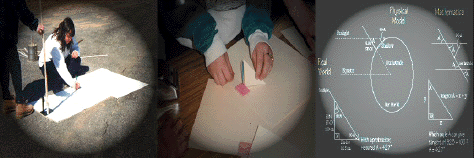 |
 |  | |
Equipped with his five senses, man explores the universe around him, | |||
Our everyday experience of the world around us is
an invitation to question and explore and wonder:
 |
 |  | |
Equipped with his five senses, man explores the universe around him, | |||
Our everyday experience of the world around us is
an invitation to question and explore and wonder:
During the day, we see a bright sphere called the Sun move across the sky. Its path is
fairly regular from day to day, but changes gradually during the 365-day seasonal cycle. Why
doesn't the Sun always rise in the same place each day? Where does it go at night? How does its
light cast shadows on our world?
We experience the alternation of daylight (day) and darkness (night). Clocks show us that the total time needed to complete one day and one night always is 24 hours, but the proportion of each varies for different 24-hour periods. Also, we can see that the Earth never is completely light or dark at one time. How can it be noon in Boston, 5 PM in London, and 9 AM in San Francisco at the same time? Who has the right time?
Much of the Earth's population experiences a repeating pattern of temperature and weather changes over a 365-day period. Weather goes from generally cool days (spring) to hot days (summer) to cool again (fall) and then to cold (winter) and back to cool. These seasonal changes affect animal and plant life dramatically. They are of varying duration and varying character at different locations on the Earth. How can we have summer in the USA and winter in Australia at the same time, if they both turn toward the Sun once a day?
Mankind has wondered about these and other aspects of our ordinary experience for millennia. For generations, people just like us have observed and pondered and guessed about the world we live in. They have constructed "models" to explain the phenomena around us and have refined and changed and discarded these explanations based on further observations and reflections. Much of our current understanding is built upon the inspiration of observers and inquirers going back before Plato (427-347 BC); we owe much to the inspired work of Copernicus (1473-1543), Kepler (1571-1630), and Newton (1642-1727).
Today we know that the Earth is a mostly solid sphere that turns on its axis once every 24 hours. The Earth revolves around the Sun, a very large and very hot sphere of gas situated millions of miles away from us. One such revolution takes approximately 365 days. The Earth is tilted on its axis of rotation with respect to the Sun, and this tilt, coupled with the Earth's movement around the Sun, causes the alternation of our seasons. The Moon, in turn, is a smaller solid sphere that revolves around the Earth about every 28 days. It reflects the light of the Sun and shows us its "phases", depending upon the relative position of the Sun, Earth, and Moon.
Although these and other modern scientific explanations can become complicated and even can run counter to our intuition, they really are rooted in the everyday experience of people who wondered about the world around them. This is the essence of science: to be explorers of our own world, to engage ourselves in the Spirit of Inquiry by observing what is around us, asking questions and looking for answers that are consistent with our experience. And although we cannot hope to reconstruct all scientific understanding from first principles, each one of us can be a scientist with regard to our own experience. We can observe the world and wonder about it and see how our observations and deductions mesh with scientific knowledge.
For example, everyone "knows" that the seasons are "caused" by a tilted Earth revolving around the Sun. But what does this really mean? How can we know that the Earth is tilted? How can we know it revolves around the Sun? And what do the Earth's revolution and tilt really have to do with seasons, anyway? Can we find something in our experience that lends credence to these notions, so that we can deeply understand the facts and not just believe them because we are told that they are so?
 |
| The boy or girl who leaves school without some knowledge of science, some appreciation of what science has done for this world of ours, who does not wish to learn more, who does not desire to be a scientist, has failed dismally to get an education, has failed to enable himself or herself to live a full life, has put aside a great opportunity. -- Pulvermacher and Vosburgh in The World About Us 1930 |
An Inquiry-Based Classroom
In our Everyday Classroom Tools project, we are seeking to immerse elementary school
students in the Spirit of Inquiry, to help them begin to observe and learn from their experience.
Our project is rooted in a connected, progressive set of observations and questions which we can
use to explore the world around us. We look for answers to these questions that are consistent with
our experience and with the accumulated knowledge of humankind. At all times we try to keep
ourselves rooted in our own observations. We strive to maintain a connection between what we are
exploring now, what we have learned in the past, and what we hope to understand in the future.
What the Everyday Classroom Tools project wishes to stress is that before there were
encyclopedias, there were authors, and before there were scientific facts, there were curious people
trying to explain the world around them.
There are more questions we could ask ourselves about the world around us than we
present here, because for every observation, there can be millions more questions we find and
want answered. Hopefully, those questions will be ones which appear in our classrooms from
eager and inquisitive students. The first question we asked ourselves when we embarked on this
project was "Where do we start to build a curriculum based on these principles?"
Our efforts to date have taken the form of the Threads of Inquiry, a series of free-flowing
dialogues about inquiry-inspiring investigations that maintain a solid connection with our
experiences and with one another. The Threads are meant to be a jumping-off point for teachers,
suggesting an approach to the Spirit of Inquiry without dictating too much of the content. Of
course, they are backed by more formal on-line activities, and they also operate in accordance with
contemporary concepts in science education for elementary students (such as the National Science
Education Standards). We understand this classroom method may be new for some teachers, and so we provide an additional text guide to using inquiry in the elementary school classroom. Please read the article entitled The Keys to Inquiry, an in-depth look at the practices of constructivism and inquiry in the elementary school classroom. This piece was written by Tina Grotzer, a research associate of Project Zero at the Harvard Graduate School of Education. Her work details the research regarding cognitive development of children, offering techniques for bringing out the best in your students' question asking and answering skills, observation and recording abilities, while its text provides key classroom examples for different grade levels.
The major theme explored in this curriculum is the pattern of change on planet Earth as it
relates to the Sun. So many different subjects can be usefully mapped to this set of investigations
of the world around us that it gives educators an opportunity to build upon an inquiry framework
with their own related and connected ideas from different disciplines.
Here is a look at each of the different investigations and its main aims:
To Seek or Not to Seek? Skills: Observing, collecting, question asking, examination of data, recording of data, changes, patterns, science as a tool.
Topics: Life cycles.Hello, Sun! New Skills: Measuring, modeling, predicting, theory building.
Topics: Sun's path in the sky, Sun's height in the sky, Sun-Earth motions, length of day, degrees.You Light Up My Life New Skills: Manipulating objects, experimenting with theories.
Topics: Nature of light and shadows.Me and My Shadow New Skills: Using our bodies as tools, thinking about information in different ways, believing a theory by testing it.
Topics: Nature of sunlight as straight rays.Guess My Shape New Skills: Thinking in more dimensions, bringing our experiences from outside back into the classroom.
Topics: Nature of three dimensional space, geometry of solids, nature of shadows hitting three dimensional objects.This is a Stickup! New Skills: Careful data collection, working with real number data, drawing conclusions from our own data, making models of our experiment.
Topics: Speed of Sun's path across the sky, triangles and angles, degrees on the sky.Latitudes and Attitudes New Skills: Using three different sound methods for finding an answer, combining number data and recent experience to draw conclusions.
Topics: Latitude and longitude, Calculating our latitude, angles, triangles, degrees on the sky.Time Warp New Skills: telling time, building tools to tell time, thinking about time and position on the world.
Topics: Time and subtraction of times, time zones, Sun's path across the sky with relation to relative time, degrees and angles.Tilt-A-World New Skills: Combining data with observations, believeing what we are experiencing by testing the data in terms of math and models.
Topics: Value of the Earth's tilt, orbit of the Earth around the Sun, seasons.Through Thick and Thin New Skills: Taking everything we have learned about shape, the movement of the Sun, the tilt of the Earth, the passage of time, and the nature of light to believe in the changes we have seen all year.
Topics: Graphing, calculating area, temperature.